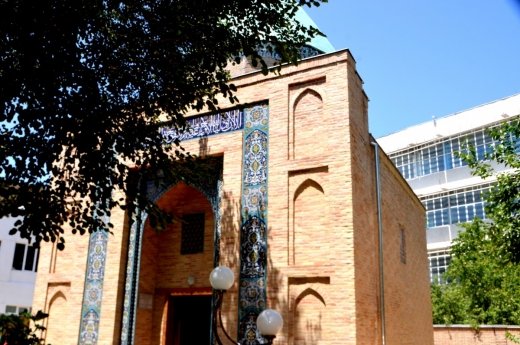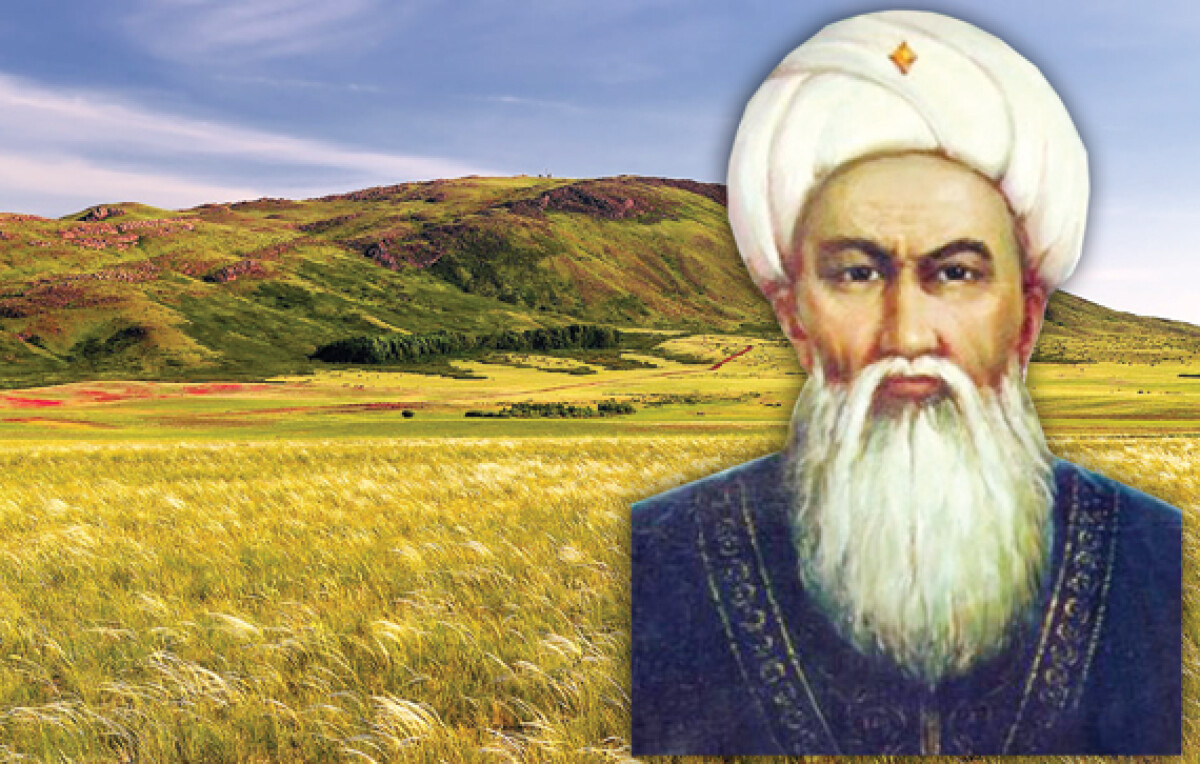
knowledge of customary law, and eloquence. In addition, the supreme judicial power was possessed by the khan, who had the right to review the decisions of the biys court. Speakers are orators and biys undoubtedly occupy an important place in the history of our people. The most outstanding of them are 3 biys: Tole bi, Aiteke bi and Kazybek bi. It was quite right when scientists note that the three judges, who are eternally remembered amongst grateful descendants of Tole bi, Kazybek bi, Aiteke bi, - were not only gifted with oratorical art, but had a significant impact on the society.
They, just like Cicero in Ancient Rome, used a wide range of government duties, including the biys courts, thereby affirming the principles of the democracy of the Great Steppe by their activities. It was the great oratorical art, first of all, which put them in the line of historically significant persons of the Kazakh ethnos. Along with them it is necessary to highlight the activities of Kazakh zhyrau, and akyns. In ordinary Kazakh law, the case could not be initiated on the fact of the crime, the process began only on the initiative of the victim. The plaintiff was called daulaushy or talapker, and the defendant was sauap berushi or jauapker. In addition, representatives of the plaintiff and the defendant, witnesses - aigak and oaths - msan beruya participated in the trial.
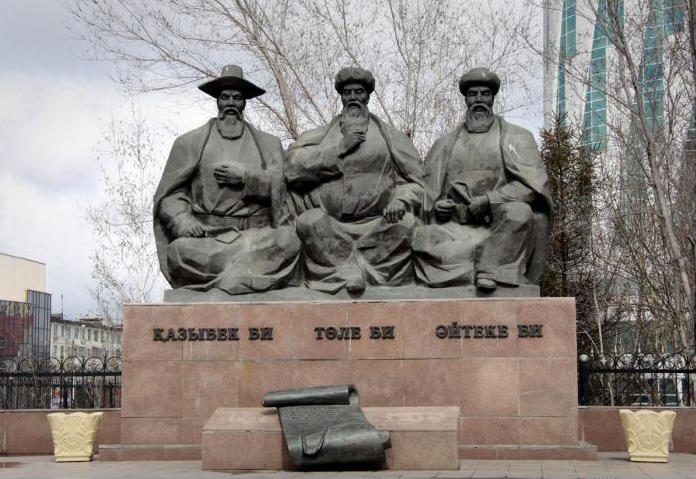
The court on customary Kazakh law was open, competitive, all cases, both criminal and civil, had a claim. The biys were chosen by mutual agreement of the parties, and biju could be given a challenge, but only before the beginning of the process. The examination of the case began with a rite of casting before the pleading judge by the plaintiff and the defendant. This symbolized the agreement of both sides with the composition of the court and agreement, with the future decision of the biys. Attempting to challenge, beating, after throwing lashes or obstructing legal proceedings was punished, the perpetrator could beat him with the whip. The centuries-old history of the nomadic Kazakh people has preserved many names of great personalities, vivid representatives of the national cultural heritage on the pages of the annals. By their noble deeds, these glorified ancestors forever remained in the people's memory, like people who have a rare gift, wisdom and sober thinking, resourcefulness and boldness of judgment on the most burning issues of life.
The political and social significance of the institution was primarily due to the Kazakh Khanate, that was the first national state in Central Asia created by the now existing Kazakh ethnos. "Kerey and Zhanibek in 1465 founded the first state, and the history of Kazakh statehood started back then," as President Nursultan Nazarbayev notes. "Perhaps it was not a state in the modern sense of the term, in the present borders, with such renown and authority throughout the world. But this can be said about all other states of that era. It is important that at that time the foundation was laid, and we are continuers of the great deeds of our ancestors."
It emergence on the political map of that time clearly indicated the boundaries of the ethnic settlement of the Turkic tribes and clans that later formed the Kazakh ethnic community. As historical documents testify, the state ideology, laws, courts of biys and other elements of the state structure existed; it was an independent body of international relations on the Eurasian continent, having wide foreign connections. At the same time, the ethnic and socio-historical processes that took place in the present territory of Kazakhstan have deep roots that go back thousands of years. By and large, the continuation of these historical processes was precisely the formation and formation of the Kazakh Khanate.
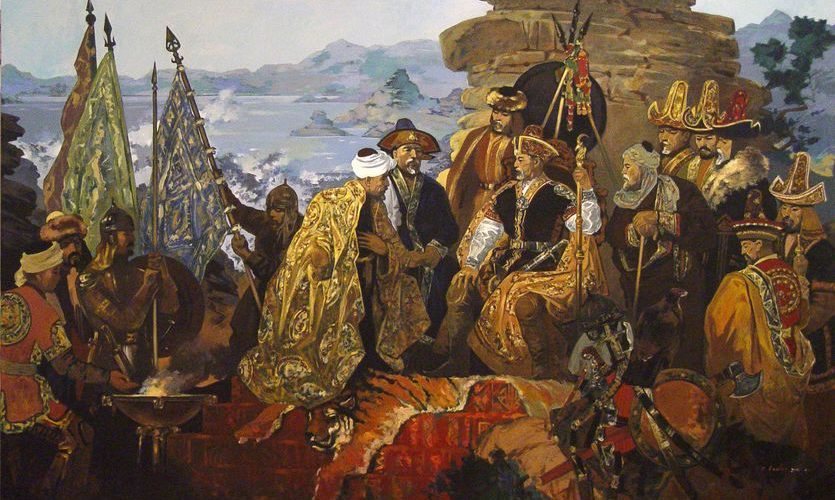
Thus, a vivid example of the formation of the statehood of the original Kazakh Khanate was the Kazakh law, the greatest treasure of the cultural life of the Kazakh people and the entire nomadic civilization. Kazakh law has a thousand-year history, the peak of approval of which researchers conditionally refers to the fourteenth to the fifteenth centuries. The paradox of this phenomenon lies in the fact that the early decline of the greatness of the Great Steppe of the Kypchaks - the ancestral home of the nomadic civilization - did not lead to a synchronous decline of prestige and the role of the Kazakh legal culture. In the nomadic societies from the ancient times up to the Kypchak Khanate and later the Kazakh Khanate, as noted by the outstanding Kazakh scientist, Academician Salyq Zimanov, due to the high degree of continuity, the traditional notions of law, law and justice were an integral part of the state concept of the steppe civilization .
And the Kypshak statehood itself, with the most developed system of steppe civilization, has its roots deep into the centuries. Undoubtedly, in the framework of Kypshak statehood, there was a set of steppe law with its regulations and orders. But it is important to note that the fundamental modernization of the state legal system, first of all, can not fail to take into account the diverse national factors of the development of our country. Indeed, the current state and legal system of the Republic of Kazakhstan is a consequence and result of its historical development based on the legal heritage of the Kazakh people, and, first of all, the Kazakh people as a state-forming ethnos.

As Shokan Ualikhanov puts it, in order to obtain the name of bi, it was necessary to show to the people more than once his legal knowledge and his oratorical ability. The potential bis often underwent training in the eastern madrassahs in Khiva, Bukhara, Samarkand. They passed from generation to generation their legal knowledge based on the canons of the Sharia and everyday moral experience. Beeves in the Kazakh steppe were many.
They were of different scale - local (rural), regional, or tribal. 'Bi' in Kazakh means "a judge elected by the people".
By the beams of all biys the people of the three from the cohort of the rulers of the last quarter of the XVII and the first half of the eighteenth centuries called Tole bi (1663-1756), Kazybek bi (1667-1764) and Aiteke bi (1644) -1700), whose date of birth and place of death is set approximately. At one time, Herold Belger, who did extensive research on this matter, said that in the people's mind, they are mentioned in indissoluble unity and a clear sequence. For all the commonality of views and political aspirations, each of them represented a certain zhuz: Tole bi - the senior, Kazybek bi - the middle and Aiteke Bi - the junior one.
All of the three fficially remained in their zhuzes as rulers, but also as advisers to the khans, including Abylai khan. All three respected, honored each other, leading a correspondence among themselves, part of which was shirking from loss and oblivion. One of the sons of Kazybek bi took the daughter of Tole bi. Aiteke bi, died before the other two great biys, there is no written data about him. However, the people remembered that Aiteke bi was younger than Tole, but older than Kazybek. It is known that there have been disputes between biys. And here Aiteke bi as if keeping the other two in balance, and both obeyed him, the last word was left for him. Three great sons of the people have become an enduring symbol of unity for the Kazakhs. They clearly defined the strategic path of the people for all future ages.
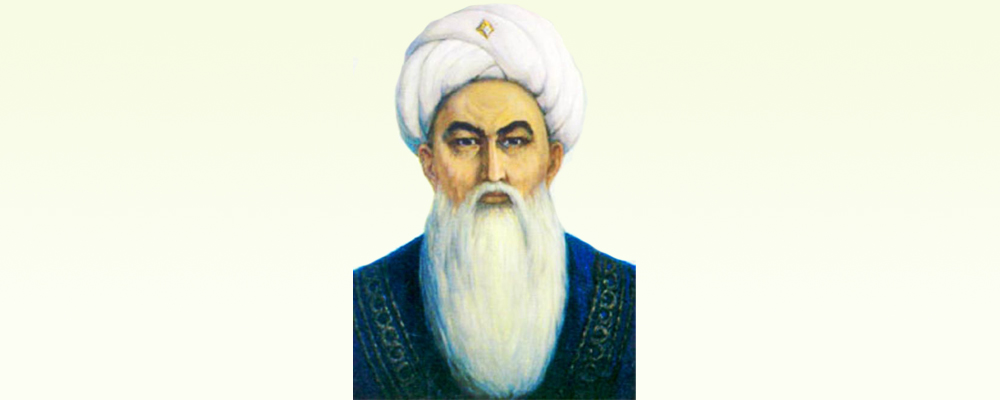
He was born in 1663 in the village (that was the name of the neighbors of the janys) of the Zhaysan tract, near the banks of the Shu River, in the Shuya district of the Zhambyl region. He died in 1756 in the Akburkhan orda, now the Lenger region of the South Kazakhstan region. Between these two dates, determining the age of a person, years of great, tense and interesting life were laid for studying. Father of Tole bi - Alibek was descended from the Kazakh taipa dulat, the subgenus of Zhanys. Grandfather - Kudaiberdy bi participated in the campaigns of Yesim Khan, in particular in the battles "Katagan Kyrgyz" (1627-1628), against the insurgent Tursyn khan, who run Tashkent.
Under the name of the most numerous tribe of the Senior zhuz, Tole Bi was known as Uysun Tole bi, the Uyssuns themselves called it Janys Tole bi. At the behest of his father, the boy Tole began to learn from the age of five. His education was handled specially for him by a mullah from Bukhara Abushakir. Since Bukhara at that time was the center of Sufi thought, widespread in Kazakhstan, especially as a result of active political activity in Turkestan.
Tole bi's upbringing and self-development was significantly influenced by the family tradition that absorbed the worldview and culture of the Turks of the Great Steppe. His genealogy originates from the worthy descendant of the legendary Maiky bi, his worthy descendant Bakhtiyar bi, who was popularly told: "The tribune begins to speak, the leader begins to lead the people".
Since childhood, Tole bi has grown very observant and resourceful boy. He was invariably attracted by people of venerable age, wise and sedate. And the white-bearded aksakals gladly blessed him, seeing in him a rare gift. Tole has successfully passed the tests and a kind of accreditation from the ptriarch-wise men. For example, he tried this kind of test at the century-old Anet-Baba, famous in the steppe of the learned old man. According to one parable, once a boy Tole came to the old man Anet baba. The elder began to tell him about the unity and harmony of the people.
Being with his father on trips to different regions of the steppe, the boy quickly learned the knowledge. Moreover, he showed early maturity in comprehending the secrets of history, literacy and legal culture of his people. Tole Alibekuly is awarded the title of judge of the Dulat at the age of twelve. In the winter in Tashkent, he inexperiably got acquainted with the book treasures of the libraries of the Karakamys and Akburkhan mosques. And for fifteen years he becomes an independent path of bi. Thus, Tole bi as a talented, literate person who has absorbed the traditions of the oratorical poetic art of his people since childhood, becomes the most famous Kazakh public figure, the famous orator, the chief judge of the Senior zhuz - one of those who wrote the Zhety zhargy.
Tole bi, as well as the Chief Justice of the Middle zhuz Kazybek Keldybekuly and the Chief Justice of the Junior zhuz Aiteke Baibekuly, the three of them were the main advisers of Tauke khan. Tole bi actively participated in the fact that Tauke khan made Turkestan the capital of the Kazakh Khanate in order to subordinate all three zhuzes to a single center in order to strengthen the Kazakh Khanate in order to create a military alliance of kindred peoples against the Dzungarian aggression. After the death of Tauke khan, the Kazakh Khanate began to disintegrate. Tole bi, heading the Elder Zhuz, was at some time dependent on the Dzungarian conquerors. Living in one of the most terrible centuries of the existence of the Kazakh Khanate, he turned out to be one of the inspirers and organizers of the struggle against the Dzungarian Kalmaks.
There is a tradition according to which people everywhere began to leave their places of haste in a hurry, Tole bi did not disassemble his home. "Why are not you going to leave?", they asked him. "Yes this year, one swallow settled at the top of the yurt. It's a legendary bird: during the flood, when Noah's ship sank, she saved him. I can not ruin her nest and destroy her chicks, "answered the wise Tole. "Yes, this is truly holy," said the Kalmyk commander and did not touch him and his entourage. In the environs of Tashkent and Shymkent, the tradition of not directly mentioning the name of Tole bi, and saying "The sacred swallow" (Karlygash bi), has survived.
Despite the fact that he paid the Kalmaks tribute, political management took over. Tole bi played an important role in uniting the Kazakhs, in freeing them from the Dzungarian shackles. According to some information, he helped Sultan Abylai to rise.
The great Bukhar zhyrau in the poem describing the childhood of Abylai khan reminds the khan how, when in a difficult situation, he worked at Abilmambet and passed camels at Tole bi. In the poem "Sabalak" Bukhar zhyrau describes the conversation between Tole bi and Abylai - a boy-pack in an old sheepskin coat, which Tole called for his hair and disheveled appearance Sabalak. So, too, Sabalak sheep, always with a bag, serious, unshakable. Apparently, Tole understood people in people, once he paid attention to the teenager. It's not for nothing that they say that the breed is visible to children.
Thus, Tole bi was one of the first to notice Abylai khan's potential.
Three hundred years ago, the Kazakh and Dzungarian khanates were constantly enraged. And in the spring of 1723, taking advantage of the disintegration of the Kazakh Khanate, after thorough preparation, the Dzungarian ruler Tsavan Rabdan, began a massive invasion of his troops in seven directions into the territory of Kazakhstan. The Dzungars wanted, using the existing circumstances, to destroy the Kazakh people, and to enslave the survivors. According to Shakarim Kudaiberdyuly, two-thirds of the steppe population died. It is not without reason that an expression was born, meaning the period 1723-1727 as "Aktaban shubyrindy, Alkakol sulama" (The years of great disaster).
In the early spring of 1729, a new invasion of the Dzungarian troops began on the Kazakh land. Tole bi discovered the qualities of personality inherent in the leader, the head of the people. Having teamed up with the batyrs Kabanbai, Bogenbai and Janibek, he created a united people's front for the struggle for freedom and independence. There is evidence that Tole bi personally participated in the battles with weapons in hand.
"There is no more famous batyr than Kabanbai, there is no biah that would surpass Tole bu", noted a prominent Kazakh poet, publicist, ethnographer and educator Mashkhur Zhussup Kopeyuly.
According to another parable, a jigit named Tulki asked Tole bi:
- Who are the six-armed people of Alash?
"The six-wheeled Alash are the children of Kazakhs, Karakalpaks, Kyrgyz, Uzbeks, Turkmen and their offspring," replied Biy.
- And three zhuzes - who are they?
- Three zhuzes - the children of three native brothers-Kazakhs
- How can I wash off the grudge for my relatives? - the jigit did not lag behind.
- Meeting after a long separation.
According to historical information, the legendary Anrakay battle became an outstanding event in the liberation war of the Kazakh people against the Dzungarian invasion. It occurred in the first half of the eighteenth century in the area of Aniracay, 120 kilometers from the southern tip of Balkhash lake, near the sand of Taukum. After this major victory, the Kazakhs began to liberate their land from the Dzungarian aggressor. Wise Tole bi said: "Who saw his father, shoot to learn who the mother saw, he will be able to sew a fur coat". This is one of his most famous sayings.
Especially he was stern of traitors. His sentence to one of these renegades became a standard in solving similar disputed cases:
Fortunately, when a son is born to his father,
Fortunately, when he follows in the footsteps of his father.
But if the son of the corrupt does not wash himself
Shame the most vile from your face -
Drive him away!
The merit of Tole bi, as a visionary politician, consisted in the consolidation and unification of the Kazakh people as an unbeaten fighter for the creation of a centralized state. When considering each judicial question, Tole bi emphasized the importance of the unity of the Kazakh people for the present and future of the country.
His wise saying went into the story: "A noble thought has a source." Such well-known personalities as Asan Kaygy and Zhirenshe used to correct Tole bi as a support for rulers, noted his eloquence and concern for the needs of ordinary people. But it was with the writing and implementation of the so-called "Seven commandments" ("Zhety zhargy") of Tauke khan, that the name of the sage Tole bi firmly entered the consciousness of the people. Later, the authority of Tole bi increased, and in connection with the call to the people to take up agriculture, move from nomadic to settled, combining livestock breeding with the conditions of city life, learn good examples from neighboring peoples, thereby taking care of future generations.
In 1733, Tole bi initiated the epistle to the Empress Anna along with a group of sultans and biys, following Abulkhair's acceptance of Russian citizenship in 1731. According to a letter, the Senior zhuz was accepted into Russian citizenship, but this remained only on paper. At the same time, Tole Bi did much to establish and develop ties between the Senior zhuz and Russia. In 1749, in a reciprocal letter from Neplyuev, he approved the intention of the senior zhuz to join Russia, proposes to take the development of trade relations between the two peoples into their own hands. Tole bi always called upon his people to be patient and persevering, saying that if the people were selenium united, fraternal solidarity, then it would become a model for future generations. The ruler will justify his destiny with high thoughts about the good and unity of the people, and selfish jigit, no matter how he himself has blubbed, only in the aul will be known, and for his own profit he will sell his friend.
The great biy was distinguished by extraordinary severity in the sentencing, always assuming the possible death of a person as a consequence of even a minor misconduct of another person. That is the reason among the Kazakhs was a warning: "Save God from the words and look of Tole bi!" Once solving the case of petty theft, Tole bi ordered to tie the stolen horse tripod to the legs of three horses and decided that if the tripod ruptured, the thief would be punished with a fine, if this does not happen, he will be exempt from paying the kuna. When the horses were driven in different directions, the straps were put through. And here, the bi stressed that the strength of the people is in strong ties, which bind the taipes and clans. And no one and nothing can break the nation and tear off their land from the Kazakhs.
Talking about life and great affairs of Tole bi, it should be noted that the main basis of power of Kazakh bis had always been outstanding spiritual qualities, deep intellect, unselfishness and justice, a gift of eloquence, invaluable experience and high responsibility. The wisdom of Tole bi also manifested itself in the fact that he did not consider a man who could speak beautifully, inexorably clever.
In oral folk literature, many legends about Tole bi have survived: proverbs, sayings, sayings have been widely disseminated, the authorship of which the people attribute to Tole bi. The sage of the Great Steppe actively participated in the construction of architectural structures in the cities where he managed to rule: Shymkent, Turkestan and Tashkent. The wisdom and resourcefulness of Tole Bi were recognized by Bukhar zhyrau, Kazybek bi, Aiteke bi. In relation to Tole bi they said: "A good thought has a source, its author has the spiritual father of Mikey," meaning that he absorbed the spirit of Mikey-bi. In their works Tole bi recognized and considered a support for the khans Sinyr zhyrau, Girince, who celebrated his eloquence and concern for the needs of ordinary people. After the period of the "great disaster", the authority of Tole Bi increased due to his appeal to the people to take up farming, to move to a settled way of life, to learn good examples from neighboring peoples. His expression is known: "Who has seen his father, will learn how to shoot, who saw his mother, how to sew a fur coat."
After the death of the khan of the senior zhuz, Tole bi ruled Tashkent for six years - from 1743 to 1749 years.
Tole bi was a supporter of equality of women and men. To his sister-in-law, Danagul, he noted that she should not avoid her father-in-law as that was an obsolete custom. By the end of his life, the wise old man fell seriously ill. This message, like the sad melody of a kobyz, flew around the expanses of the Kazakh steppe. All the notable and famous people hurried to the Great Biy. The poet Zhanyl came to say goodbye to him and asked about the unfulfilled dream of Tole bi. White, like a lun, a wise man uttered: "Oh, my daughter, I've lived so long that I already dream about what happened." When I was born, Kazakhs and Kirghiz lived like brothers in one state, and now between them there is a crack and they depart from each other. I dream that once again everyone who remembers me, who reads a prayer for me, aspires to unity. According to Shokan Ualikhanov, the Russian cossacks of Semirechye, as well as the settlers, often addressed the biys, since in these courts the case was resolved openly and without paperwork. So, the laws of the "Zheti zhargy", to the creation of which he put his hand and Tole bi, practically functioned until the establishment of Soviet power in Kazakhstan.
He died in the ninety-third year of life. He was buried in Tashkent and a mausoleum was erected at the burial site. People still come to him from all over the world to worship the glorious ancestor. In oral folklore, there are many historical legends about Tole bi.
Here's one of them. In Tashkent, on the memorial plaque of Tole bi, it is written as Karlygash bi. Karlygash means Kazakh sacred bird. How come Tole bi had such a name?
Tole bi, as you know, lived in a time that was troubled for the Kazakhs. The Dzungar invaders now and then made devastating raids. Once they invaded the territory of the Senior Juz. All fled in panic, fleeing in the mountains and steppes, and only Tole bi did not leave his yurt. The leader of the jungar, noticing the lonely yurt on his way, came into perplexity and ordered one of the soldiers to find out what kind of madman he was not afraid of. Dzhungar warrior galloped up to Tole bi and threatened that, for example, he could lose his life for such impudence.
Tole bi calmly pointed to the shanyraq - the wooden frame of the yurt. "See, the swallow's nest twisted. And while she does not lead the chicks, how will I get out of the way? You, of course, can decapitate me, but my life is not more valuable than the life of future chicks. Is not it?" The warrior rode back and brought the words of Tole bi to his leader. He immediately ordered to stop the robbery. "The people who have such a wise man can not be enslaved." From that time on, people called Tole bi Karlygash bi.
In honor of Tole bi, a village in Zhambyl region was renamed, which is the administrative center of Shu district and is located near that city. In Turkestan region, there is an administrative-territorial unit - Tole bi district, the administrative center of the city of Lenger. His name is born by streets in the cities of Astana, Almaty, Karaganda, Taraz, Kyzylorda, Shymkent, Turkestan and many other places in Kazakhstan. In 2003, the postal department of Kazakhstan issued a postage stamp with a picturesque portrait of Tole bi.
In memory of Tole bi - the great ancester and famous man of the 17th-18th centuries, the central avenue of the ancient city of Taraz was renamed, and the majestic monument to an ancestor was solemnly opened, which became another bright sight of southern Kazakhstan. Tole bi nowadays is one of the significant figures of his era and his achievements are highly recognized by the Turkic-speaking peoples. The efforts of Tole bi, as a wise man, batyr, a man of just and managerial ability to unite Turkic-speaking peoples, historians are evaluated positively. Thanks to the activities of such prominent personalities as Tole bi, Kazakhstan society has achieved good development.
